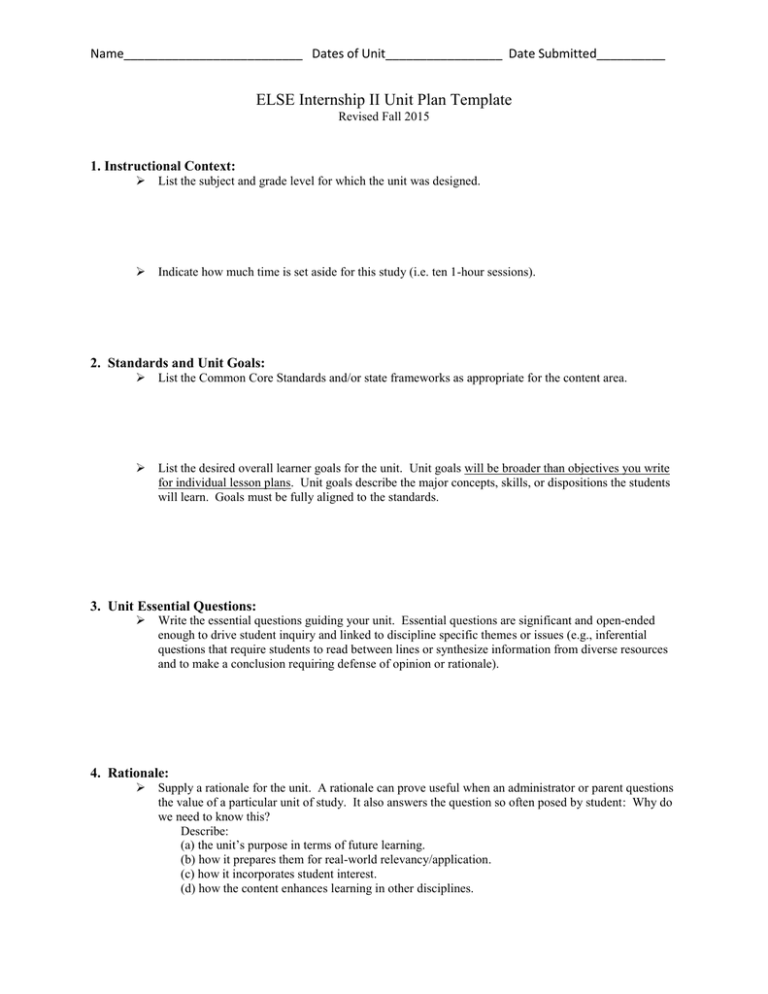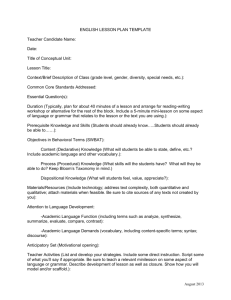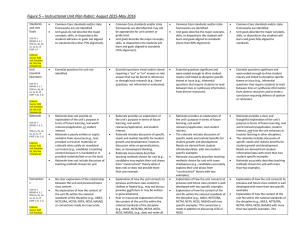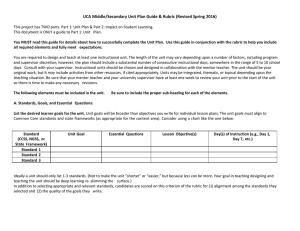Unit Plan Template
advertisement

Name__________________________ Dates of Unit_________________ Date Submitted__________ ELSE Internship II Unit Plan Template Revised Fall 2015 1. Instructional Context: List the subject and grade level for which the unit was designed. Indicate how much time is set aside for this study (i.e. ten 1-hour sessions). 2. Standards and Unit Goals: List the Common Core Standards and/or state frameworks as appropriate for the content area. List the desired overall learner goals for the unit. Unit goals will be broader than objectives you write for individual lesson plans. Unit goals describe the major concepts, skills, or dispositions the students will learn. Goals must be fully aligned to the standards. 3. Unit Essential Questions: Write the essential questions guiding your unit. Essential questions are significant and open-ended enough to drive student inquiry and linked to discipline specific themes or issues (e.g., inferential questions that require students to read between lines or synthesize information from diverse resources and to make a conclusion requiring defense of opinion or rationale). 4. Rationale: Supply a rationale for the unit. A rationale can prove useful when an administrator or parent questions the value of a particular unit of study. It also answers the question so often posed by student: Why do we need to know this? Describe: (a) the unit’s purpose in terms of future learning. (b) how it prepares them for real-world relevancy/application. (c) how it incorporates student interest. (d) how the content enhances learning in other disciplines. Name__________________________ Dates of Unit_________________ Date Submitted__________ The rationale should include discussion of specific needs and realistic benefits for student growth and development. Needs are derived from student information/data with student-specific examples. The rationale should accurately describe teaching methods chosen for the unit. 5. Connections: Provide an explanation of how the unit connects to previous and future class content. Use specific examples. Explain how the content of the unit fits within the national standards of the discipline (e.g., ACEI, AMLE, NCTE/IRA, NCTM, NSTA, NCSS, NASAD). Use specific examples. This is in addition to previous connection to Common Core Standards. 6. Learner Development: Explain how the unit is developmentally appropriate for all the students. Discussion of the unit’s developmental appropriateness includes various developmental categories (e.g., cognitive, linguistic, social, emotional, physical). Major theorists/theories for learner development (e.g., Piaget, Vgotsky, Erikson, Kohlberg, Gilligan) are referenced with specific examples. Reference specific students and how information on students was collected and will be used. Include discussion on how to support students to build on strengths and strengthen areas of weakness and provide examples. Include an explanation for differentiation of unit content and/or delivery for specific students. Include a class profile for each class that will be taught this particular unit. (COPY & PASTE CLASS PROFILE(S) HERE.) 7. Learner Diversity: Provide a discussion of diversity categories in your classroom (e.g., learning styles, ethnicity, language, exceptionalities, gender, gender identity, and SES). The information should reference specific students and how information on students was collected and will be used. It should include a discussion on how to support students and provide examples. It should also include an explanation for differentiation of the unit content and/or delivery for specific students recognizing how diverse learners process information and develop skills or planning multiple approaches to learning that engage a range of learner preferences or including multiple perspectives to include learners’ personal, family, community, and cultural experiences and norms. Name__________________________ Dates of Unit_________________ Date Submitted__________ 8. Assessment Plan: Provide an explanation for assessment design/selection (e.g., rationale that fully explains all assessments) and provide criteria for quality work. Explain how the assessment can be used to support student growth. Provide an explanation about lesson adjustment based on preassessment and/or formative assessment results and provide examples of differentiation for student needs and interests and/or learners in their own self-assessment. 9. Lesson Objectives (found in Lesson Plans): Lesson Objectives should be written as measureable student outcomes. Objectives should describe the major concepts, skills, or dispositions the students will learn and the objectives should be aligned with the goals. 10. Instruction (found in Lesson Plans): Lessons should reflect a consistently student-centered focus (e.g., inquiry, open ended activities) with all lessons using student-centered approaches. Lessons should include a variety of instructional strategies with options for more than one “right” or “correct” answer or solution. Methods should allow learners autonomy in examining new concepts in relationship to their existing content knowledge and engage learners in identifying diverse perspectives in the discipline. Instruction should provide evidence of frequent opportunities for collaboration between teacher/student and student/student. Collaboration is more than simply “group work” and involves students having roles, responsibilities, and individual accountability. 11. Lesson Plans: Use required format for all daily lesson plans involved in the unit of study. Be sure to date and label Day 1, 2, 3, etc. Lessons should be articulated (e.g., substitute teacher could implement based on level of written detail) describe specific concept, skills, or dispositions the students will learn. Lesson plans should fully align objectives, activities, and assessments. Lesson plans should follow a logical sequence and follow the required format and include all required elements. 12. Assessments (found in Lesson Plans and Unit Plan): Make sure you use, design, or adapt a variety of classroom formative assessments and they are fully aligned to the learning objectives and activities. Lesson Plan assessments will be evaluated. Assessments should include a variety of approaches with options for more than one “right” or “correct” answer or solution. All pre/post/formative assessments and scoring guides should be provided. Students should be given opportunity to self-evaluate and reflect on their own work and/or give peers feedback and/or create assessment criteria. (INCLUDE PRE/POST/FORMATIVE ASSESSMENTS AND SCORING GUIDES) 13. Critical Thinking (found in Lesson Plans): Lessons should address Blooms taxonomy with primary focus on higher levels (analysis, evaluation, synthesis). Name__________________________ Dates of Unit_________________ Date Submitted__________ Planned activities should engage students in critical or creative thinking and problem solving. Students are provided opportunities for input, choice, or opinion. Learners are asked to independently identify issues, problems, or questions of interest and of real world relevance and explore possible solutions, actions, or answers and are provided opportunities to gather, organize and evaluate information and ideas from digital and other resources and from different perspectives. Learners are provided opportunities to demonstrate their understanding in unique ways (e.g., invention, combining ideas, model making, visual illustration, metaphor) and explain their choices. 14. Materials and Resources (found in Lesson Plans): Use multiple resources beyond the textbook to prepare for the lessons and to present activities. Materials include non-text based resources. Materials needed for lessons are listed and an explanation is given for how all materials support student learning. When technology is used, it is used to support student learning (e.g., providing learners opportunity to engage in inquiry/research (analysis/evaluation) and/or in the creation/synthesis process and/or to expand options for learner choice). (COPY & PASTE LESSON PLANS HERE)




